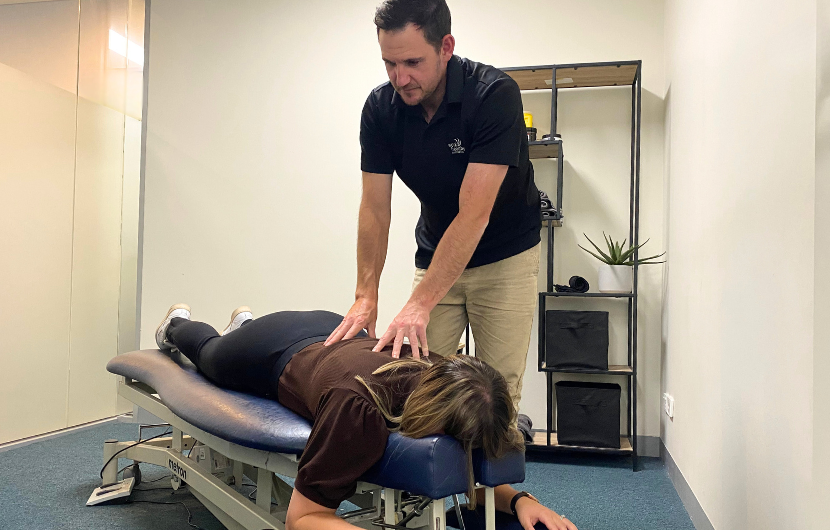
Onsite care enables early assessment and treatment of workplace injuries, reducing the risk of long-term claims and downtime.
Workplace injuries are costing businesses time and money. According to Safe Work Australia, musculoskeletal disorders make up 35% of serious claims every year. That’s why more workplaces are making the switch from the ineffective traditional approach to the proactive, consolidated, onsite early intervention model. Read on to find out why onsite care might be right for your business.
A common scenario causing headaches
It’s 10:42 am on a Tuesday. A supervisor walks into your office – again – with a worker nursing a sore shoulder after a repetitive task on the floor. “It’s probably nothing,” they say, but you know where this can lead. Time off. Paperwork. Claims. Offsite GPs and Physios making duty modifications without understanding your workplace. Another worker is off the floor, and the team is under pressure. For OHS and safety leaders, this scene is all too familiar.
What’s the better alternative? We all know the answer: A workplace operating safely and efficiently, with employees engaged in proactive health behaviours and early access to treatment before minor injuries become major disruptions. But the reality is, many organisations are stuck in the counter-productive cycle of reactive occupational healthcare – sending injured workers offsite for care, creating delays, inflating costs, and putting productivity and employee morale at risk.
Onsite injury management brings experienced occupational clinicians into the workplace to assess, treat and manage injuries where they happen. This approach reduces downtime, supports recovery, and enables faster, tailored interventions that meet the specific needs of organisations.

Why onsite treatment benefits workplaces
1. Early access to treatment reduces Lost Time Injuries
Early access to treatment is key to preventing minor injuries from escalating into chronic conditions. Onsite healthcare providers deliver immediate care, helping employees recover faster. This approach minimises downtime and lowers workers’ compensation costs by addressing issues before they require extended leave or complex treatments.
We know that early contact and support leads to better health and recovery outcomes. Evidence shows that an employee is more likely to stay at or return to work when potential risks are identified, their individual needs are assessed, and treatment and/or rehabilitation services begin as soon as possible.
2. Proactive early intervention
Onsite healthcare providers assess workplace ergonomics and identify risk factors contributing to musculoskeletal disorders (MSDs). Through floor walks and spending time onsite, they develop a deep understanding of your workplace. This, in turn, helps them deliver tailored recommendations that mitigate risks and prevent injuries before they occur. This proactive approach promotes a safety culture and reduces the frequency of claims related to MSDs.
For example, if a worker experiences shoulder pain from repetitive tasks, they can get immediate onsite treatment, adjust their work technique, and stay on the job instead of taking sick leave.
Early intervention is critical to helping workers with an injury or illness recover and return to work faster. It has been shown to significantly reduce the impact and duration of emerging symptoms of illness or injury, and may also assist to prevent secondary or chronic conditions.
3. Cost savings, efficiency and increased productivity
Investing in onsite treatment delivers measurable financial benefits. By reducing the incidence and severity of workplace injuries, organisations can significantly lower their workers’ compensation premiums.
Additionally, employees can receive treatment onsite, while at work, spending less time travelling to off-site appointments. This has an immediate impact on productivity and operational efficiency.
On average, our clients will get $3.00 return for every $1.00 they invest in our onsite injury prevention program. Not to mention the gains when it comes to employee retention, improved morale and productivity.
Darragh McGovern, National Operations Manager, Work Healthy Australia
4. Tailored solutions to your workplace
No workplace is the same. Onsite healthcare providers develop customised programs that align with the specific demands of your industry. Onsite clinicians familiarise themselves with your workplace, workforce characteristics, job demands, and operational requirements.
They walk the site floors, engaging with supervisors and workers during these walks. This partnership gives them valuable insights that enable them to understand your business, unlike an off-site solution. Interventions are tailored to fit your environment and requirements
We aim to keep the same clinician at the one site for an extended period of time, to ensure they gain a good understanding of the site, its employees, processes and systems. This also promotes trust and consistency in the treatment room.
Darragh McGovern, National Operations Manager, Work Healthy Australia
5. Supporting employee wellbeing
Providing onsite treatment demonstrates a commitment to employee health and wellbeing. This not only boosts morale but also encourages early reporting of discomfort or injuries, creating a supportive environment where employees feel valued.
Research shows that investing in employee health and wellbeing can boost employee retention and even contribute to recruitment or new talent by elevating the employer’s brand.
6. Continuous improvement through data insights
Onsite injury management programs generate valuable health and safety data that support continuous improvement.
Data insights help you identify trends and emerging risks, evaluate program effectiveness, and adapt prevention and treatment strategies in real time. Data-driven reporting ensures that injury prevention programs remain targeted, effective, and aligned with your evolving business needs.

The business case for onsite healthcare
For organisations with large workforces, the return on investment (ROI) from onsite physiotherapy is substantial:
- Reduced workers’ compensation costs: Early intervention leads to faster recovery times, lowering claim costs and insurance premiums.
- Streamlined and centralised services: Employees have a single point of contact for healthcare and safety management. Consolidating pre-employment screening, injury management, task analysis, and other OHS services saves organisations money and time.
- Improved retention and engagement: Employees who feel supported are more likely to stay with the organisation, reducing turnover costs.
- Enhanced compliance: Aligning with Safe Work Australia‘s guidelines on workplace health ensures compliance with legal obligations while promoting a safer work environment.
Injury prevention and management is not a one-size-fits-all solution that we can simply ‘copy and paste’ across all environments. We need to ask many questions to find out what is working and what is not working at organisations, and we act as partners, working together to reach a solution that meets their needs.
Darragh McGovern, National Operations Manager, Work Healthy Australia
Implementing onsite treatment: key steps
- Engage a premium onsite injury management service: There are now a number of suppliers of OHS services and onsite treatment in Australia. Ensure you partner with an experienced, high-quality service provider that understands your industry’s unique demands, has a track record of success, and employs experienced occupational health specialists.
- Engage leaders, managers and your workforce: To get the best of your onsite injury management service provider, get your leaders, managers and employees onboard and engaged with the program. Supervisors are key to encouraging employees to seek early treatment for niggles and pain.
- Measure and evaluate: Track metrics such as lost time injuries (LTIs), workers’ compensation claims, and employee satisfaction to evaluate the program’s effectiveness. A good onsite treatment provider will deliver robust data-driven insights and advice to improve your workforce health.
Case study – How this business consolidated their injury management and achieved zero WorkCover claims
Facing a rise in musculoskeletal injuries and limited return-to-work success, Ararat Meat Exports partnered with Work Healthy Australia to embed a tailored onsite injury management program. The initiative included pre-employment assessments, clinician-led task analysis, and onsite treatment twice weekly. Within months, injury claims dropped to zero, and most cases were resolved in under three treatments. The program delivered measurable productivity gains, strengthened communication with culturally diverse workers, and empowered safer task redesign. Read the case study.
Onsite treatment is a proactive approach to workplace health and safety. It reduces injuries, lowers costs, and improves productivity –all while supporting employees.
Work Healthy Australia provides leading onsite treatment services that help businesses:
- Reduce workplace injuries with proactive prevention.
- Improve recovery times with fast, effective treatment.
- Lower compensation costs and increased savings.
- Build a safer, healthier and more engaged workforce.
To find out how our onsite injury prevention model can benefit your workplace, contact Work Healthy Australia today.
Sign up to our monthly enewsletter
"*" indicates required fields
